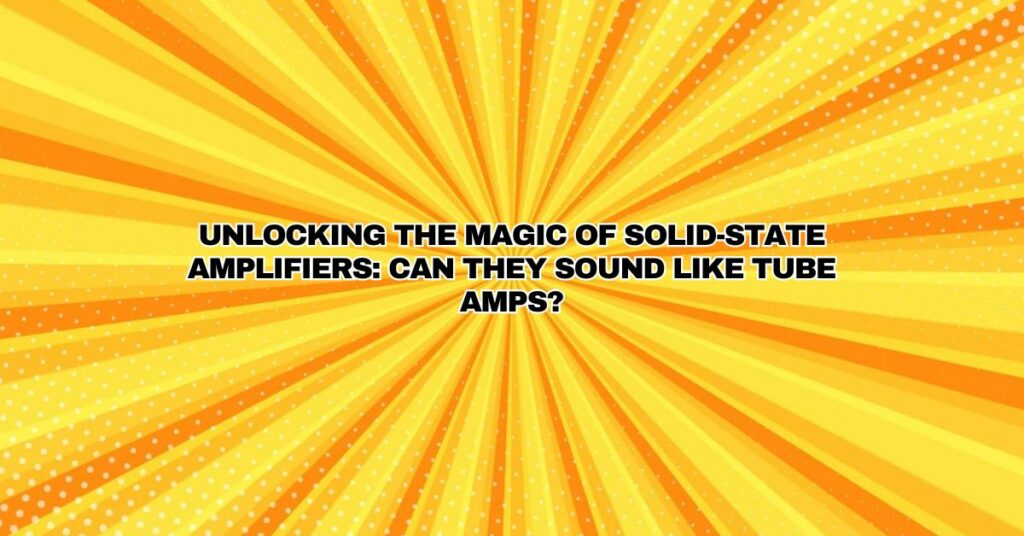The debate between tube amplifiers (or tube amps) and solid-state amplifiers has raged on in the world of audio enthusiasts and musicians for decades. Tube amps are revered for their warm, rich, and harmonically complex sound, while solid-state amps have been known for their reliability and affordability. However, advances in technology have made it possible for some solid-state amplifiers to closely emulate the coveted tube amp sound. In this comprehensive article, we’ll explore the differences between tube and solid-state amplifiers, the factors that influence a solid-state amp’s ability to mimic tube tones, and some examples of solid-state amps that can sound remarkably close to tube amps.
Tube Amps vs. Solid-State Amps: The Basics:
Before we dive into the realm of solid-state amps that can sound like tube amps, let’s establish a foundational understanding of both types:
Tube Amps:
- Warm and Harmonic: Tube amps are celebrated for their warm, natural, and harmonically rich sound. The distortion they produce is often described as “soft” or “musical.”
- Tonal Complexity: Tubes introduce pleasing even-order harmonics, adding depth and dimension to the sound. This results in a saturated, overdriven tone that many guitarists and audiophiles find appealing.
- Maintenance: Tube amps require regular maintenance, as tubes wear out over time and must be replaced. They can be delicate and are more prone to damage when moved frequently.
- Price: High-quality tube amps can be expensive due to the cost of the vacuum tubes and intricate circuitry.
Solid-State Amps:
- Reliable and Efficient: Solid-state amplifiers are known for their reliability, efficiency, and lower maintenance requirements. They don’t rely on vacuum tubes, so they have a longer lifespan and are less prone to damage during transport.
- Clarity and Precision: Solid-state amps offer precise, clean amplification without the characteristic warmth and distortion of tubes. This clarity can be an advantage in some applications.
- Affordability: Solid-state amplifiers are generally more affordable than their tube counterparts, making them accessible to a wider range of musicians and audio enthusiasts.
Can Solid-State Amps Sound Like Tube Amps?
The ability of a solid-state amplifier to sound like a tube amp depends on several factors:
- Modeling Technology: Some solid-state amps are equipped with advanced digital modeling technology. These models simulate the characteristics of classic tube amplifiers, including the unique tone and breakup. Brands like Kemper, Line 6, and Fractal Audio have made significant strides in this area.
- Analog Circuitry: While digital modeling has come a long way, some solid-state amps still rely on analog circuitry to emulate the warmth and distortion of tube amps. These amps often use specialized components and design principles to achieve a more tube-like tone.
- Speaker Selection: The type and quality of the speaker in a solid-state amp play a significant role in shaping its sound. Some manufacturers use high-quality speakers designed to emulate the tonal qualities of specific tube amps.
- Tone Shaping and EQ: Many modern solid-state amps feature advanced tone-shaping and equalization controls that allow users to fine-tune their sound. With the right adjustments, it’s possible to get closer to the warmth and character of tube amps.
- Overdrive and Distortion: The ability of a solid-state amp to replicate tube amp distortion is a critical factor. Some models use specialized diode clipping or transistor-based designs to achieve tube-like overdrive.
Examples of Solid-State Amps with Tube-Like Sound:
While it’s challenging for any solid-state amp to fully replicate the unique characteristics of tube amps, some have come remarkably close:
- Roland JC-120 Jazz Chorus: The Roland JC-120 is renowned for its clean, chorus-laden sound. While it doesn’t mimic the overdriven warmth of tube amps, its clean tone is iconic in its own right.
- Peavey Bandit Series: Some Peavey Bandit solid-state amplifiers have earned a reputation for their ability to deliver a satisfying overdriven tone that is reminiscent of tube amps.
- Quilter Labs Aviator Series: Quilter’s Aviator series of solid-state amplifiers use analog circuitry and specialized components to produce rich, harmonically complex tones that are often likened to tube amps.
- DV Mark Multiamp Series: The DV Mark Multiamp series features digital modeling technology that convincingly replicates the sounds of various classic amplifiers, including tube-driven tones.
- Boss Katana Series: The Boss Katana series of amplifiers has gained popularity for its ability to emulate the dynamics and responsiveness of tube amps through a combination of analog circuitry and digital modeling.
Tips for Achieving a Tube-Like Sound with Solid-State Amps:
If you own a solid-state amplifier and want to approach the warmth and harmonics of a tube amp, consider the following tips:
- Experiment with EQ: Fine-tuning the amp’s equalization controls can significantly impact the tone. Adjust the bass, midrange, and treble to find a sweet spot that gets you closer to your desired sound.
- Use Quality Effects: Incorporate high-quality effects pedals and processors into your signal chain to shape your tone and add texture. Overdrive, distortion, and reverb pedals can be particularly useful.
- Speaker Replacement: Some solid-state amps allow you to swap out the stock speaker for a higher-quality model that better complements your desired tone.
- Volume and Gain Control: Experiment with the amp’s volume and gain controls to find the right balance between clean and overdriven tones.
- Explore Amp Settings: Study your amp’s manual and explore different settings to discover the full range of tones it can produce.
In Conclusion:
While achieving the exact sound of a tube amp with a solid-state amplifier can be a challenge, technological advancements and innovative designs have brought solid-state amplifiers closer than ever to replicating the warmth, harmonics, and overdriven qualities that tube amps are known for. Musicians and audio enthusiasts can explore these options to enjoy the benefits of reliability, affordability, and advanced features without sacrificing the desired tonal qualities. The key is to choose the right solid-state amplifier and explore its features and settings to craft a sound that suits your preferences and musical style.


